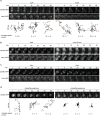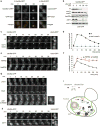Spatial sequestration of misfolded proteins by a dynamic chaperone pathway enhances cellular fitness during stress
- PMID: 24036477
- PMCID: PMC4121856
- DOI: 10.1038/ncb2838
Spatial sequestration of misfolded proteins by a dynamic chaperone pathway enhances cellular fitness during stress
Abstract
The extensive links between proteotoxic stress, protein aggregation and pathologies ranging from ageing to neurodegeneration underscore the importance of understanding how cells manage protein misfolding. Using live-cell imaging, we determine the fate of stress-induced misfolded proteins from their initial appearance until their elimination. Upon denaturation, misfolded proteins are sequestered from the bulk cytoplasm into dynamic endoplasmic reticulum (ER)-associated puncta that move and coalesce into larger structures in an energy-dependent but cytoskeleton-independent manner. These puncta, which we name Q-bodies, concentrate different misfolded and stress-denatured proteins en route to degradation, but do not contain amyloid aggregates, which localize instead to the insoluble protein deposit compartment. Q-body formation and clearance depends on an intact cortical ER and a complex chaperone network that is affected by rapamycin and impaired during chronological ageing. Importantly, Q-body formation enhances cellular fitness during stress. We conclude that spatial sequestration of misfolded proteins in Q-bodies is an early quality control strategy occurring synchronously with degradation to clear the cytoplasm of potentially toxic species.
Figures








Comment in
-
Protein folding: Misfolded proteins join the Q.Nat Rev Mol Cell Biol. 2013 Oct;14(10):608. doi: 10.1038/nrm3668. Nat Rev Mol Cell Biol. 2013. PMID: 24061221 No abstract available.
References
Publication types
MeSH terms
Substances
Grants and funding
LinkOut - more resources
Full Text Sources
Other Literature Sources
Molecular Biology Databases
Research Materials

